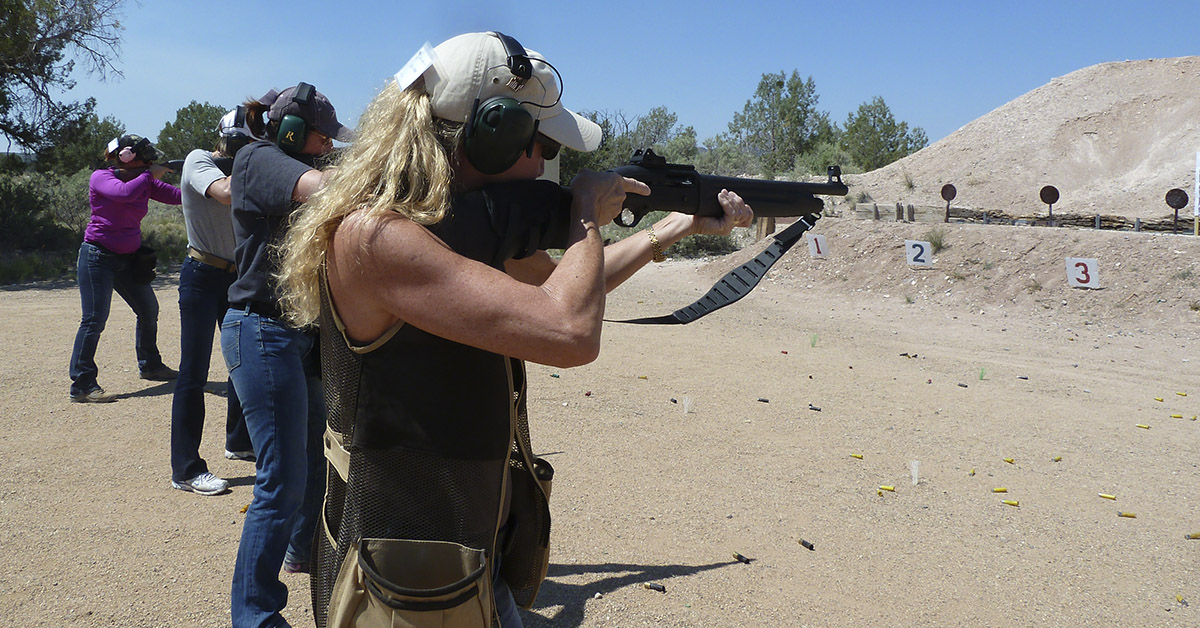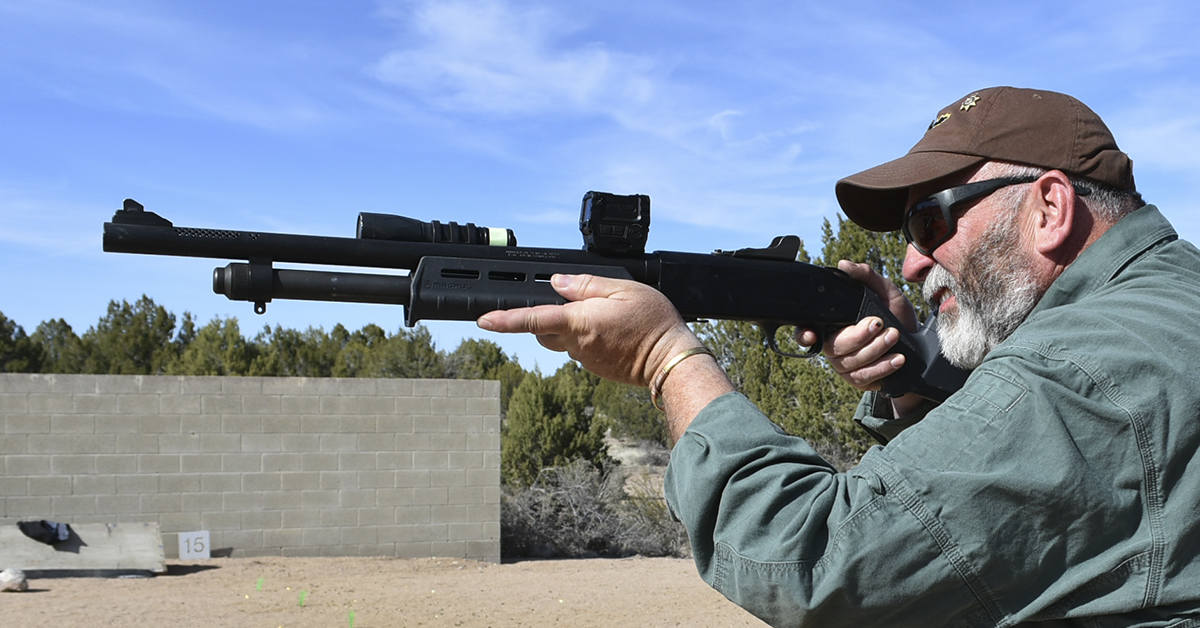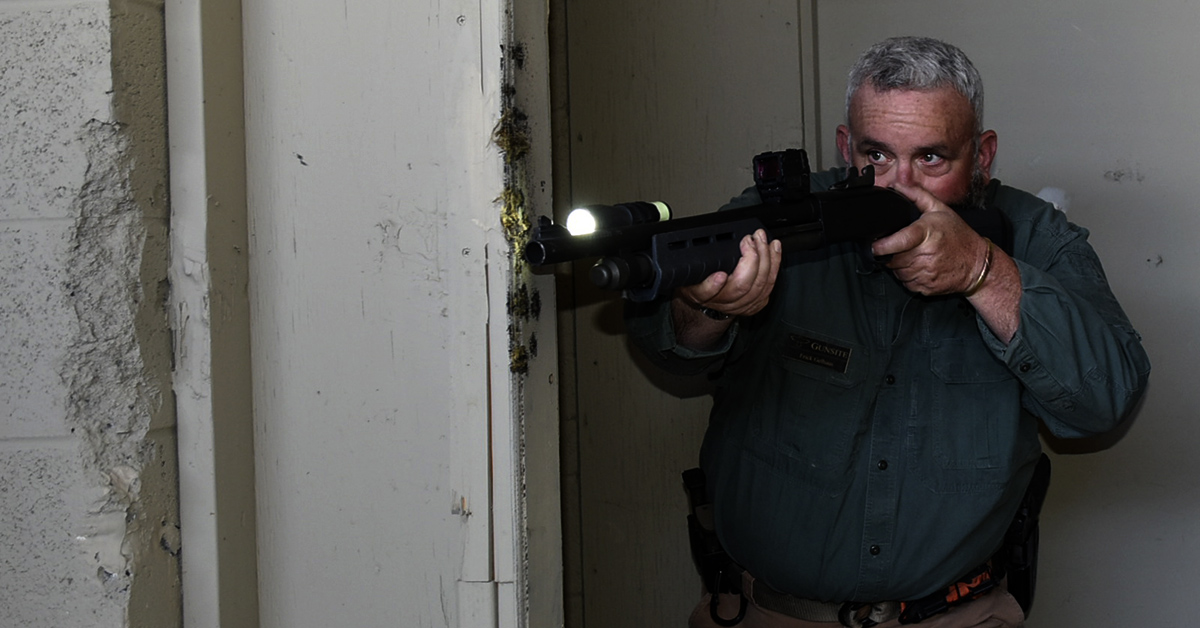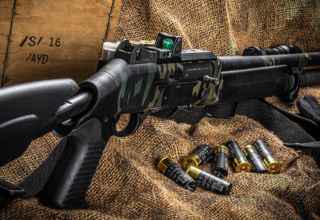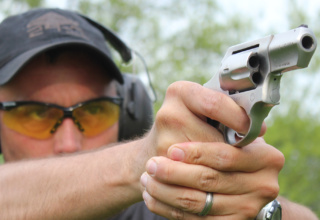In the second installment of our Trainers Talk series, Gunsite Academy instructor Erick Gelhaus discusses the shotgun and weighs in on that ever-burning question: is this the best option for home defense?
by the Shoot On staff
[Editor’s Note: This is the second part of a three-part series. Be sure to check out our first part of the Trainers Talk series where we discuss the AR-15 for personal defense.]
We can all remember, and will never forget, the year 2020. That year will forever stand as the demarcation of what we jokingly call “the before times” and whatever epoch has been unleashed in its wake.
As such historical turning points go, 2020 was only mildly violent compared to, say, the fall of Jericho, the Visigoths’ sacking of Rome in 410 A.D., or the decimation of the American naval fleet by Imperial Japan in 1941. We can call upon more examples, of course, but you get the idea. The riotous vandalism, unrestrained looting, and fiery street-level demonstrations we saw that year are only a wisp compared to other bookmarks in the course of human history. But for many, the psychological and cultural upheaval changed everything.
People became afraid. People recognized their vulnerability. And people who counted on local law enforcement to protect them realized that dog doesn’t necessarily hunt.
With this awakening, anxious citizens besieged firearms retailers — many of whom had never before owned a gun — looking for defensive weapons and ammunition. Shelves quickly depleted of arms and ammo stock hit rock bottom throughout the country. Only now, nearly three years later, has some sense of normalcy returned to the marketplace.
In October of that decisive year, we took a hard look at the shotgun — particularly the scarcity of shotgun ammunition — and how this platform can provide meaningful home defense with even the most meager and unlikely ammunition options available. In fact, we did a complete video illustrating, comparing, and discussing the real-world effectiveness of buckshot, slugs, and even birdshot as it applies to personal and home defense and for providing food in a crisis. Our takeaway was that, if you could only have one firearm during a societal Armageddon, the shotgun with its myriad ammunition options would arguably be the best choice.
What we did not get around to discussing was the practical use of and the proficiency training needed for the defensive shotgun. While many novice shotgun owners may think of this firearm as a simple point-and-shoot tool, the reality is something quite different.
There is much to consider when selecting a shotgun for defensive use, such as the optimal gauge for your needs, action type, platform style, recommended equipment, and the ammunition type best suited for your situation. Then, of course, there is the familiarization, safe handling, and proficient deployment of a shotgun for home/personal defense. In other words, proper training. A shotgun calls for its own unique skillsets to be effective, as is the case with a handgun or carbine rifle intended for defensive use.
To help beginner and experienced shotgun owners alike get a better grasp of this platform for defensive use, we tapped the knowledge base of Gunsite Academy — the most respected firearm training center in the U.S.
Established by Lt. Col. Jeff Cooper in 1976, Gunsite employs highly experienced and dedicated instructors to guide students through the pragmatic use of firearms for personal defense based on what the school defines as the Combat Triad: marksmanship, gun handling, and mindset. Gunsite’s course curriculum is extensive, with classes conducted at the academy’s headquarters in Paulden, Arizona, as well as off-site locations in Alabama, Alaska, Colorado, Indiana, Tennessee, and South Carolina.
The subject matter expert for this installment of our Trainers Talk Q&A is Erick Gelhaus.
A Gunsite instructor since 2001, Erick is a Rangemaster for pistol, shotgun, carbine, and tactics classes. He has a master’s in public administration from Norwich University and focuses on the research about use of force and decision-making issues. Erick was an infantryman in the Army with a ground combat deployment as a heavy weapons squad leader. After 29 years in full-time law enforcement, he retired from a large California sheriff’s office as a patrol sergeant. He worked in patrol, community-oriented policing, gang enforcement, narcotics, use of force/firearms, and new deputies’ field training during his law enforcement career. After promoting, he supervised a patrol shift as well as the field training and use of force/firearms programs.
– Rob Reaser, Shoot On Editor-in-Chief
The Big Picture
SO – The shotgun has been argued by many as the most practical defensive firearm for home use when compared to a rifle or handgun. There are many reasons for advocating this position — the biggest being shotgun ammunition can be better “tuned” to the environment for which it is intended to be used. What are your thoughts on this and what is your overall opinion of the shotgun platform as it relates to home defense versus a rifle or handgun?
EG – I am quite comfortable with the shotgun as a home or business defense weapon. While it may not do any one thing great, it does several things very well.
Additionally, in some places throughout our country, a shotgun may be the only choice for a defensive long gun — in terms of legal restrictions. The platform does give you choices in terms of ammunition selection; however, not every choice is a good idea in that role.
Pistols and carbines can require a greater number of shots (think servings) per Bad Guy. Shotguns rarely need more than two solid hits to be effective.
Aiming is at least as important as it is with both pistols and carbines.
Finally, the shotgun does not suffer from a difference between one’s point of aim and the point of impact.
SO – With fragmenting projectiles now commonly available for centerfire rifle and handgun applications, does the “shotgun is best” argument still hold water in terms of minimizing collateral damage? This, of course, assumes that fragmenting ammunition is really a viable option for defense (there seems to be some debate on that).
EG – Are you talking about frangible projectiles — those that are designed to disintegrate upon impact with a solid object, usually armor plate? If yes, then while they can cause injury, they are sub-optimal as a defensive load. Coming from an organization where we shoot a tremendous amount of frangible ammunition because of range limitations, I would not recommend it for defensive use.
The only fragmenting load I am aware of is a pre-fragmented slug. I do not have enough experience to recommend for or against those.
The Hardware
SO – While gun owners should always strive to find a firearm that they are comfortable with and that they can operate and shoot most safely and effectively, looking at the base shotgun platform, does your experience as an instructor lean you towards recommending a pump-action or a semi-auto shotgun for defensive use? What do you see as the pros and cons of each?
EG – Historically, the recommendation was a pump shotgun. Personally, that has shifted to a semi-auto…if the design has proven reliable.
Two reasons. First, semi-auto shotguns work more like the average shooters’ pistol and carbine. Second, I am unhappy with the QA/QC issues I am seeing from brands that were previously very well thought of. For those two reasons, I am in the semi-auto camp.
SO – The 12-gauge vs. 20-gauge debate is always present when discussing defensive shotguns. What is your take on this subject?
EG – Well, there is a place for the 20-gauge, but it may not be the panacea I once thought it was. There are not a lot of good ammunition choices for it. Even though its light weight is viewed as a benefit, the shooter still must deal with the recoil. And there is less weight to absorb that recoil.
This is one time where there is benefit to the pistol caliber carbine concept.
SO – Let’s talk aiming systems for a moment. Both OE shotgun manufacturers and the aftermarket provide many sight options, such as a standard bead front sight, red dots, tritium bead dots, tritium front post and rear notch sights, front post and ghost ring rear sights, et cetera. Do you have an opinion on which sight system is optimal for the defensive shotgun and do you see any performance differences in these sights with your students?
EG – Since I have been using optics on my carbine since ’99, and on my pistols since ’18, I prefer a red dot sight on my shotgun. Barring that, either a traditional ghost ring or the pistol-like sights Vangs is putting on some shotguns.
Any of those three will do. The bead sights, ramped or not, are not easy to use.
SO – As is common with the AR-15 platform, many folks like to dress-out their defensive shotguns with assorted accessories (such as shell holders, lights, slings…even vertical grips), thinking it will provide them an advantage. What, if any, add-ons do you feel provide a true performance enhancement and what, if any, cause more obstacles for the shooter/student than benefits?
EG – The first accessory I would get for a defensive shotgun is a weapon-mounted light. You’ll need the white light for identification of a potential threat and making the Don’t Shoot/Shoot decision. Second, [you need] a way to carry extra ammunition on the shotgun itself. This is because it is very likely that you will only have what is in and on the shotgun once you grab it.
While a sling is generally a “need to have” for training, I do not believe it is necessary in a home or business defense role. If you do use a sling for home or business defense, do not get one that holds extra ammunition on it.
Vang Comp Systems‘ barrel modification is a very solid addition, and it significantly broadens the amount of acceptable ammunition choices because of how it works.
SO – Defensive shotguns fall into three general furniture camps: fixed stock with conventional grip, collapsible or folding stock with a drop pistol grip, and the few oddities with no stock. From your personal experience and from observing students over the years, does one style offer an advantage or deliver better overall results and why?
EG – A shorter stock is generally a better choice for most shotgun users. Mine generally have a 12 5/8- to 13-inch length of pull. This allows the student to square up to the target rather than be bladed off because of the stock’s length.
While I do not like pistol-grip-only stocks, that grip angle works better for me. As a result, I really like Magpul SGA shotgun stocks because of the grip angle and being able to adjust the stock. I have them on Mossberg and Remington shotguns as well as Beretta 1301s.
I would not rule out a stock with a pistol grip if I was using it on a shotgun with the safety at the rear of the trigger guard. I have yet to see a collapsible M4-style stock that I like. I would strongly recommend against a folding stock. There is some interesting work being done with a bird’s head grip; however, I have little direct experience.
SO – Returning to ammunition for a moment, what do you advise students as to the preferred shotshell for home defense (projectile type and size, payload weight, cartridge size)?
EG – For a home defense load…I prefer a reduced-recoil 00 buckshot load. Both Federal’s FliteControl and Hornady’s VersaTite loads use a specialty shot cup that delivers consistent performance with minimal pellet spread.
While Federal no longer makes a FliteControl version of their #1 buckshot, they do have some other #1 offerings coming to market.
If large critters or intermediate barriers are a concern, then I would use slugs. But only for those. I would avoid any of the sabot slugs, as the shoes (plastic jackets) do not always fall away in flight.
Birdshot in any flavor is not an acceptable defensive load. While there is a broad spectrum of novelty loads for your shotgun, I would avoid them for any defensive use.
The Firmware
SO – As an instructor, what are the most common problems areas you see in first-time defensive shotgun students (e.g., safety discipline, understanding of operational fundamentals, marksmanship, unrealistic expectations, learned bad form, et cetera)?
EG – Manipulation is probably the biggest area of concern. First, using the mechanical safeties. From there, in order, are loading, cycling, and unloading. Third would be mitigating the recoil.
SO – What areas of defensive shotgun instruction do you see students struggling with the most and what are the solutions you present to them?
EG – Manually operating a pump shotgun. There was a time when several defensive and law enforcement shotgun shooters had grown up with a manually operated gun, and they were shooting revolvers as well. Both required the user to manually load individual cartridges, work the action — by either pumping it or pulling the trigger — and then unload it one shell (or one cartridge) at a time.
Two ways I try to help with that: a) regularly reinforce the steps by talking them through it, and b) getting them to use mantras — phrases to talk themselves through the process. For example, Boom-Chunk-Chunk for firing the shot before running the action rearward and forward. Another is Shoot 1, Load 1 or Load What You Shoot to remind them to reload the gun.
SO – Reloading a shotgun under duress is significantly more challenging than swapping a magazine in a carbine or a pistol. How do you teach students to manage their ammo and the reloading process (pump and semi-auto) under pressure?
EG – It begins with how we teach them to hold the shell they are loading into the magazine tube. I hold it between my index and pinkie fingers, with the mouth of the shell against my index finger and the brass against my pinkie. Then find the trigger guard and follow it forward to the loading port. Once the shell is in the loading port, you can rotate your fingers forward until your thumb can push the shell into the magazine tube.
If at any time you start to lose control of the shell, simply close your hand to retain the shell. We also teach ejection port loading when appropriate.
SO – Gunsite includes handgun transitioning as part of its shotgun courses. What is the theory behind this?
EG – Gunsite teaches the full spectrum of students in our defensive shooting classes — decent, normal humans, law enforcement, and the military. At least two of those student groups may have a handgun on them during an encounter. Because of that — the presence of a secondary weapon — we teach transitions in our shotgun and carbine classes.
When I was still a sergeant with my former agency, a deputy who worked for me had been in a shotgun shooting with a charging, rifle-carrying suspect. My deputy emptied the shotgun and after falling backwards had to transition to his handgun to finish the fight. While it is not common, the need does occur.
SO – With a pump-action shotgun, dry-fire practice that covers the entire cycle of operation and reloading using dummy rounds can be comprehensive. Do you recommend this or other off-range practice exercises for the defensive shotgun student?
EG – Dry practice can cover nearly the full spectrum of employing a shotgun, or any other defensive firearm, except for recoil. You can load and unload using dummy rounds. You can cycle the action, as well as reload. While still dry, you can mount the shotgun from any of the ready positions while manipulating the safeties.
I strongly recommend dry practice at least a couple of times a week to have frequent hands-on practice with the gun.
SO – What advice can you give to the aspiring defensive shotgun student who does not currently have the means or the time to receive formal training at a facility such as Gunsite but wishes to become more proficient in using their shotgun for defensive purposes in the meantime?
EG – While video may not be a 100% substitute for in-person training, it can give a student an idea of what “right” looks like. Not every competent instructor is putting out videos, though several of them have. Defensive shotgunning has not changed significantly, even though equipment has. I would look for videos from those I trained with: Louis Awerbuck, Bill Jeans, Scott Reitz, or Randy Cain. Others with good reputations would include Mike Boyle, Steve Fisher, and Tom Givens. Gunsite and others travel and teach shorter classes in different parts of the country. There can be competent local trainers offering solid classes near you.
Finally, competitive shooting is not bad. Skeet, trap, and sporting clays offer challenging targets and require solid manipulation skills. Those two things can improve your skill set.
Closing Thoughts
SO – What advice or considerations would you give someone who is looking to buy a shotgun for personal defense?
EG – First, buy the best quality defensive shotgun you can. Pre-pandemic and 2020 Riots, older Remington 870s, and newer Mossberg 590s were not that expensive. Continue looking for them. You can find a rare, good deal.
I am very impressed with some of the newer semi-autos. We are now seeing purpose defensive versions. There are some decent, lower cost imports that are viable but will need a bit of work done to them.
In terms of accessories, get a white light on it as soon as possible. Follow up with a way to carry extra ammunition on the shotgun.
Regardless, once you get one, seek out competent instruction and then practice.
Finally, there are some myths about defensive use. Just racking the shotgun will not scare off criminals. You must aim the shotgun if you expect to get good hits. Training will address these concerns and more.
Editor’s Note: We want to thank Gunsite Academy and Erick Gelhaus for this valuable insight into the real-world application of the defensive shotgun. If you want to learn more about Gunsite Academy’s course offerings, visit Gunsite.com.
Stay tuned for the next installment of Trainers Talk when we explore the defensive handgun.
- Shoot ON’s Annual Excellence Awards - December 12, 2025
- MTM Case-Gard Introduces Compact Carbine Rifle Case - November 26, 2025
- Burris FastFire E Enclosed Emitter Red Dot Debuts - November 26, 2025


